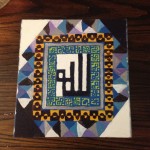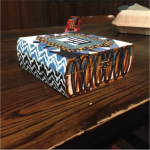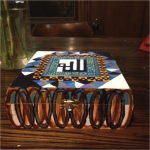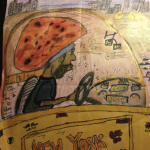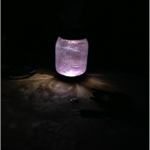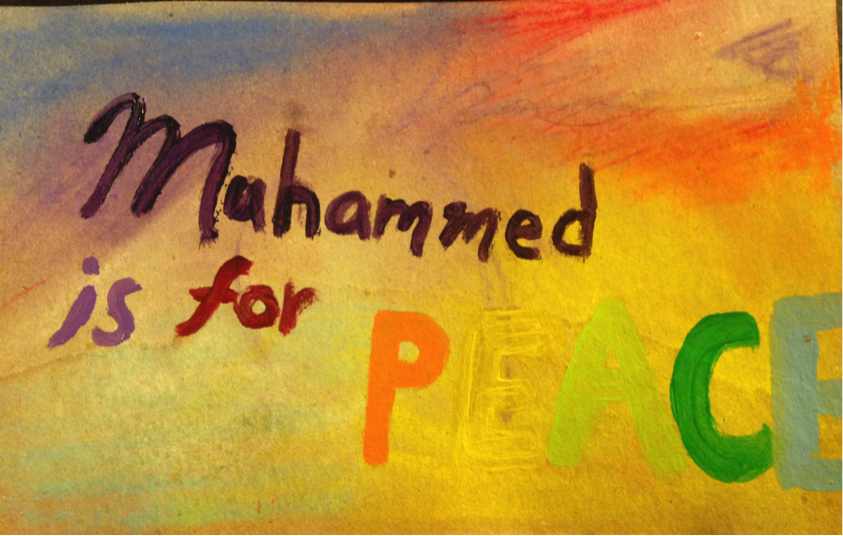Lauren Gooden
Professor Asani
5/8/14
The Islamic Aesthetic: Portfolio Introduction
Throughout this class I was challenged by a few questions first my question was what is the Islamic aesthetic and who has authority over it? But, the better question came to light as the class continued: Is there an Islamic aesthetic and can anyone have the power to define it? I came into this class understanding that not only was islamaphobia rampant in the United States, but western ideals of art and spirituality alongside religion really color my own interpretation of the art I would study, and I wanted to do something about it, if I could.
I was set on undoing some of the norms and stereotypes that I inevitably carry as a non-Muslim American. I wanted to look at the texts we engaged with from the most open perspective possible, as well as acknowledge the notions and islamaphobic tendencies I might have personally. I came in thinking of Islam and its associated practices in a sort of rigid manner. I think western idealists tend to see Islam in terms of what is allowed and what is not, a set of rules—more akin to the way the Catholic religion functions in the United States, from a cultural perspective.
I initially approached the texts and themes with this same perspective of strict rules and regulations, so to speak, of practice and worship. But, I later tried to come at the texts and art from a different angle. When I started to see the multiple ways of interpreting stories that are part of the Islamic tradition, even transposition of the Qu’ran is not exactly reliable. Week two revealed some more details about calligraphy and the Arabic language.
For the first blog piece, I was inspired by the first reading in the text, Seven Doors to Islam. John Renard refers to the “mystical imagination”[1] where one mystical interpretation of the Verse of Light struck a chord for me. It starts with “God is the Light of the heavens and the earth”, and ends with “light upon light; God guides to His light who He will. And God coins similitudes for human beings, and of everything God has knowledge”(Q 24:35). Here we see at least some sort of suggest of a connection or inspiration between God and humans, as if this light can be passed on or experienced by human beings. While prophets clearly have a special relationship with God, sometimes viewed as messengers or righteous leaders often prosecuted for their actions or belief. Yet, it is not so clear how close and the nature of the interaction between God and human beings.
In the second blog piece I went for an idea for a campaign around islamaphobia and the oppression of Muslim people. In the third week, I enjoyed Asani’s reading the most. I thought it was salient and straight to the point and it inspired me to think of my own little piece of this country and how I might combat oppression or social awareness at the least. Asani talks of the political maneuvering to paint president as Obama as a Muslim person in order to discredit him by painting him as the other. Asani writes “Post 9-11 America has witnessed a range of public figures, from evangelical preachers and media personalities to political analysts and talk show hosts, proclaiming that America is at war with Islam because, in their view, its values are anti-American”[2]. This quote brought me back to my larger question, is their a Islamic aesthetic in the sense that we can define music art and action as Islamic based on their significance or value. I think an effective way to fight for social justice is to display the truth. I wanted to make something that could be seen by many and have an impact in even the slightest of ways on their vision of what Islam is.
Following in the same vain, I posted a story of “seeing “Light” in life and how I interpreted it to work. We’ve talked about Light as God but also, seeing that light in nature. I contemplated what that meant, what it looked like. I added two photos to the story as well, I attempted to take a picture of light during the day and light in the dark to symbolize Light in the dark and light of life, or when its going well, and when life is not easy—God is there, but you have to see the signs, this light.
In the first week we read Professor Asani’s 1st chapter in Infidels of Love, where he wrote of the religious tensions in Pakistan within Islam and Muslim. He notes, “[e]ver since the seventh century when the Prophet Muhammad first began preaching his message, the question “who is a Muslim?” has been the source of intense debate. ” This highlights exactly the point that this reflection as well as my experience in the class was moving toward, what defines the aesthetic comes from the individual.
My attempt to represent an aesthetic of Islam failed in one way because there is no aesthetic as the one who worships defines it. I think bringing my cultural context and personal experience into the posts and interpretations make the connections between not only stronger, but truer. Through this course I have realized that the Western view not only demonizes Muslims and Islam, but it depicts it in a rigid, rule-oriented way that is misrepresentative. The first idea in this class that I really held on to was the connectedness of all religious scripture, and specifically the recognition of the Torah and the bible as previous iterations of God, but they are all the word of God, and in the most inclusive sense, the Qu’ran claims all believers of God, even following a different book, are Muslim, “believers”.
My blog posts attempt to accomplish or imagine what political or social action could be done, as well as delve into the intricacies of Islamic art. Yet, the last two posts, really focus on the emotional side of the experience of Islam and God. I wanted to do something truly inspired and come full circle from the first post, which talks about that spiritual experience and inspiration.
Learning about Sama really inspired me for two reasons. First, startin when I could walk and up to this day, I spin with my head cocked to the side which gives me a sort of moment of ecstasy, so it was interesting to see the video of the Whirling Dervishes in class. While that is something I have always done, I actually felt like I had some new insight into myself. As these Whirling Dervishes are looking for a spiritual moment with Sama, I think about my habit of spinning when I feel happy maybe I’m just trying to celebrate with God in a moment of ecstasy.
The second reason I was drawn to the concept of Sama was because of the tie to music. Ever since I can remember music really spoke to me. Right away the idea of Sama made sense to me. My experience with music is extremely spiritual. When African-Americans were enslaved they used spirituals to get them through. Hiphop is a direct modern day extension of that survival tool. Most black male I met has a hiphop go to song when they need to be lifted, and I do the same. A gospel or rap song that speaks to truth and logic and soul-servicing is a necessity. For that reason, the idea of sama having this power was completely believable. I didn’t think it was only about sex like some students but rather divine ecstasy that potentially sex may accomplish, but that is not Sama.
The last piece on the blog is the most complex one. I had a lot of pride in it and I took my time too paint the design. I was very committed to it being a visual representation of my mental conception of Islam, but also, to be true and inspired. My take away from this class was that true and inspired energy put into art and practice are key. Rather than an aesthetic there is a practice of worship and art production that is true in spirit, and that is the heart of Islam.
What seems to be key in America as well as internationally is the need for activism and justice for many Muslims. The question that I and others must ask theirself, how I am making assumptions or stereotypes in order to take them apart. There is a strong presence f Muslims in America, yet their presence is unbelievably segregated. The majority of non-Muslims in America may not even encounter a Muslim person. As the statistics around socioeconomic status, educational achievemt, health risk and status,etc., start to display a downward, negative trend it becomes clear that America has officially thrown Muslims into the category of “minority” or “other”. Their statistics are very comparable to those of African-Americans and Latino people, and they are moving closer. Before 9/11 this was not the case. That says something is very wrong, we need to eradicate stereotypes and representations of Muslim in the media in order to combat the structural racism that Muslims experience in this country. What my blog project attempts to do, is to change some of that picture, to represent alternative forms of engaging with the religion and understanding it.
[1] John Renard, Seven Doors to Islam: Spirituality and the Religious Life of Muslims
(Berkeley: University of California Press, 1996).
[2] Asani, Ali. Infidels of Love: Exploring Muslim Understandings of Islam, 2013, Harvard University Press
